Understanding How Humic Acid Fertilizers Regulate Nitrogen, Promote Phosphorus, and Preserve Potassium for Sustainable Green Agriculture
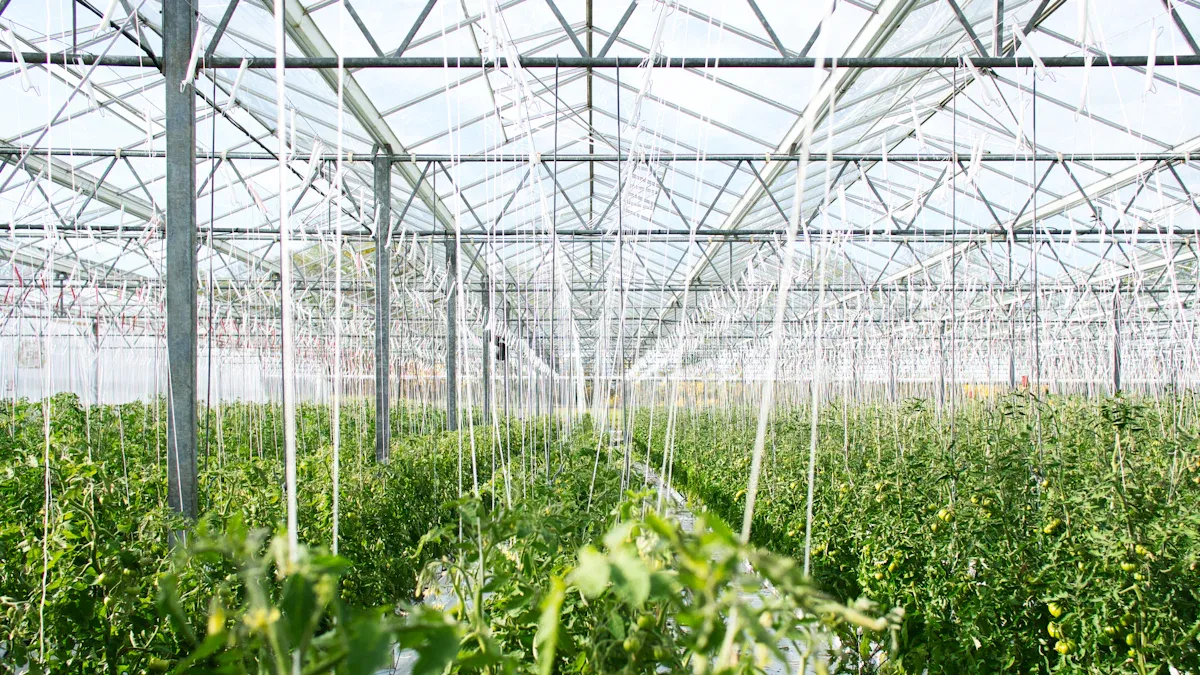
Humic acid fertilizers are important for sustainable farming. They help soil stay healthy and manage nutrients better. Farmers who use these fertilizers get a 136% rise in soil cation exchange capacity. They also see a 12% increase in crop yield. Humic substances make soil structure better and help plants take in more nutrients. They also help soil hold more water. This makes farms healthier and cuts down on using chemical fertilizers. More people are using humic acid fertilizers as sustainable farming becomes more popular.
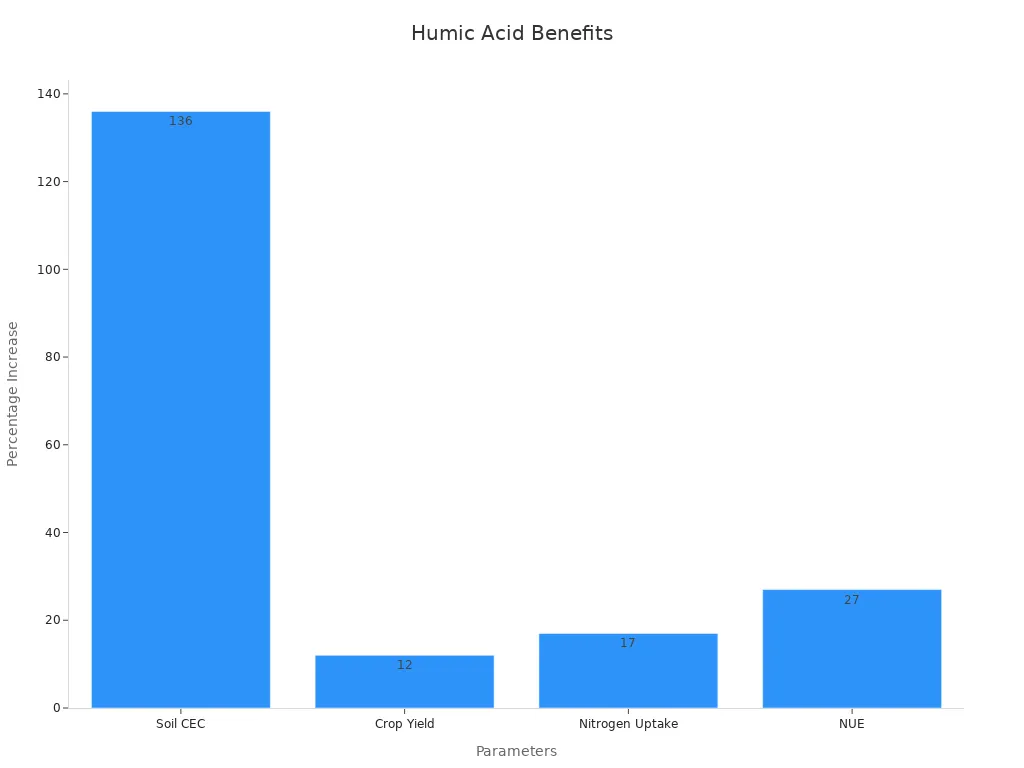
Key Takeaways
Humic acid fertilizers make soil better by holding more nutrients and water. This helps crops grow stronger and gives bigger harvests. These fertilizers help control nitrogen by stopping it from being lost. They slow down how fast urea breaks apart. They also help good soil microbes, so plants use nitrogen better. Humic acid helps plants get more phosphorus by breaking hard minerals. This lets plants take in more phosphorus for better growth. These fertilizers help soil keep potassium longer by making soil structure better. They also let potassium release slowly, so plants get nutrients all season. Using humic acid fertilizers helps farms use fewer chemicals. It helps good soil microbes grow. It also lowers greenhouse gases and makes farms healthier and more productive.
Humic Acid Fertilizers
What They Are
Humic acid fertilizers come from broken-down plants and animals. These fertilizers have humic substances like humic acid, fulvic acid, and humin. Scientists say humic acid can dissolve in alkaline liquids but not in acidic ones. Farmers and scientists like these fertilizers because they help soil and nutrients. Chemical tests show humic substances have special groups that can hold metals. These groups help humic acid grab onto iron, zinc, copper, and manganese. Because these fertilizers are organic, they help farms stay healthy and use fewer chemicals.
Note: Humic acid fertilizers help move nutrients from organic matter to plants, so crops get more of what they need.
Key Properties
Humic acid fertilizers have many helpful traits for soil and crops. Studies show that using these fertilizers and rotating crops changes humic substances. These changes add more carbon, more C-O groups, and more O-alkyl-C, phenolic-C, and free radicals. Special tests like infrared and 13C NMR prove these changes and show humic acid works better in soil.
Tests show humic acid from fertilized soil has 5.9% more carbon and 7.6% less oxygen.
Crop rotation makes the (N + O)/C ratio go up and adds more aryl, phenolic, and carbohydrate groups.
Fertilizing increases O-alkyl-C and phenolic-C, making humic acid fertilizers richer in organics.
Studies with numbers prove humic acid fertilizers help farming. The table below shows important properties and what they do:
Property | Effect in Soil and Crops | Notes |
|---|---|---|
Cation Exchange Capacity (CEC) | Goes up in acidic soils | Helps soil keep nutrients |
Total Organic Carbon (TOC) | Gets higher in treated soils | Adds organic matter and helps soil fertility |
Exchangeable Calcium and Sulfur | Goes up with humic acid use | Makes more nutrients available |
Total Phosphorus Concentration | Higher in soils with humic acid | Helps plants take in more phosphorus |
Hormone-like Biochemical Effects | Helps plants grow better | Uses auxin, gibberellin, and cytokinin activities |
Humic acid fertilizers make soil better, help plants get phosphorus, and help crops grow in tough places. The organic and humic substances in these fertilizers are important for keeping soil healthy.
Nitrogen Regulation in Soil
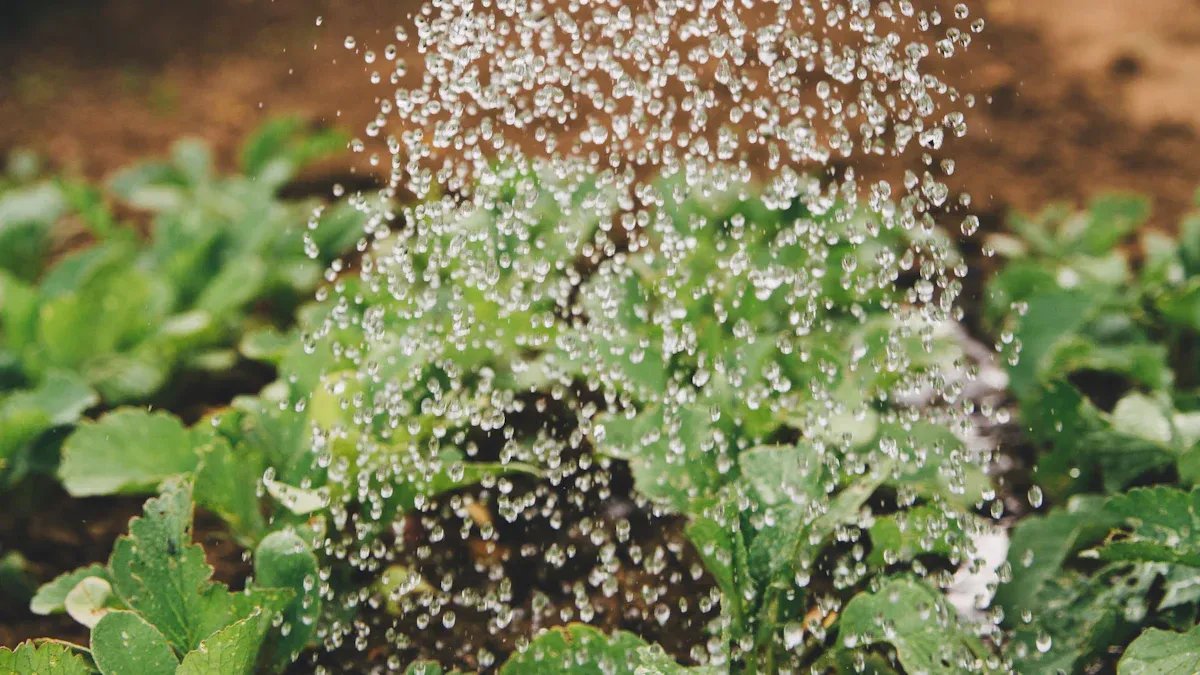
Mechanisms
Humic acid fertilizers help control nitrogen in soil. They use different ways to stop nitrogen from being lost. These fertilizers help plants take in more nutrients. Humic substances grab ammonia and keep it for plants. This stops ammonia from escaping into the air. They also hold ammonium inside their structure. This helps lower the amount of ammonia that is lost. Humic acid slows down urease activity. This means urea turns into ammonia more slowly. Less nitrogen is lost this way. These actions keep soil healthy and help plants grow strong.
Mechanism | Description |
|---|---|
Adsorption of ammonia by humic acids | Humic acids hold ammonia, making it available for crops and competing with soil microbes. |
Incorporation of ammonium into HA structures | Ammonium from urea stays in the humic acid structure, lowering ammonia loss. |
Inhibition of urease activity | Humic acid slows urea breakdown, reducing nitrogen loss and increasing nutrient availability. |
Buffering soil pH and microbial stability | Humic substances keep soil pH stable, supporting healthy microbial communities. |
Suppression of denitrification | Humic acid represses denitrification genes, reducing nitrogen loss through gas emissions. |
Targeting denitrifying microbial communities | Humic substances lower the number of bacteria that cause nitrogen loss. |
A study showed that adding 6% humic acid to compost helped a lot. It made total nitrogen go up by 24.5%. It also cut down on ammonia loss. The humic substances lowered the number of denitrifying bacteria. This means more nutrients stay in the soil. Plants can grow better because of this.
Efficiency Benefits
Farmers get many good results from humic acid fertilizers. These fertilizers help plants use nutrients better. This leads to more crops being grown. For example:
Guo et al. found that humic acid in special fertilizers made nitrogen use better. It also cut down soil N2O emissions by up to 32.6%.
Biochar-based fertilizers with humic acid let nitrogen out slowly. This stops it from washing away and helps plants get more nutrients.
Ghafoor et al. said these fertilizers released 69.8% of nitrogen in 30 days. There was little leaching and high efficiency. This helped cotton grow well.
The world market for humic acid fertilizers is getting bigger. This is because they work well for soil and crops. Studies show that mixing humic substances with other fertilizers helps plants grow. Plants use nutrients better and soil stays healthy. Farmers see stronger plants and better soil. These benefits help the environment. They stop nitrogen from being lost and help farms last longer.
Tip: Using humic acid fertilizers gives farmers more crops, healthier plants, and better soil. It also helps protect the environment.
Phosphorus Promotion
Soil Availability
Humic acid fertilizers help soil give plants more nutrients. When farmers use humic substances, they change hard phosphate minerals into forms plants can use. Humic acid works with soil and lets out nutrients that were stuck. This makes more nutrients for plants and helps them grow.
Studies show artificial humic substances change the soil. They help more phosphate-solubilizing bacteria and microbes that make phosphatase grow. These changes make acid phosphatase work better and change phoC gene groups. Because of this, humic acid fertilizers help nutrients move in soil and give crops more phosphorus.
The table below shows how soil gets better after using humic acid fertilizers:
Parameter | Natural Soil (Black Soil) | Artificial Soil (LS-FePO4) | Fold Increase (Artificial vs. Natural) |
|---|---|---|---|
Total Phosphorus (TP) (mg/kg) | 900 | N/A | N/A |
Available Phosphorus (AP) (mg/kg) | 180 | 14.3 times higher | 14.3 |
Soil Organic Matter (SOM) (%) | 1.28 | 9.03 | ~7 times higher |
Shoot-to-Root Biomass Ratio | 2.32 (control) | 3.11 - 3.63 (humic acid treatments) | Increased by ~35-57% |
Moisture Content (Stem) (%) | N/A | 90.6 | N/A |
Moisture Content (Root) (%) | N/A | 84.5 | N/A |
Humic acid fertilizers can make soil have up to 14.3 times more available phosphorus. They also add more organic matter and help crops grow better.
Plant Uptake
Humic acid fertilizers do more than help soil. They also help plants take in nutrients better. When humic substances reach plant roots, they help plants grow and take in more nutrients. Crops get stronger roots and bigger shoots.
Tests in fields show humic acid fertilizers help crops take in more phosphorus. For example, wheat with rock phosphate and humic acid took in 236% more phosphorus than wheat without it. When farmers used more humic acid, phosphorus uptake went up to 259%. Maize and barley also showed better growth and more nutrients with humic substances.
The table below shows how humic acid helps crops take in more nutrients:
Treatment Concentration (mg C L⁻¹) | Increase in Dry Biomass (%) | Increase in Phosphorus Uptake (%) | Increase in Phosphorus Absorption Rate (%) |
|---|---|---|---|
2.5 - 5 | 14.7 - 27.9 | 9.6 - 35.1 | 22.1 - 31.0 |
10 - 25 (raw HA) | Similar stimulatory effects | N/A | N/A |
Humic acid fertilizers also lower soil pH and send out H+ ions near roots. This helps break down phosphate minerals and gives plants more nutrients. Because of this, crops take in more nutrients, grow better, and give higher yields.
Farmers who use humic acid fertilizers get stronger crops, better soil, and plants that use nutrients more efficiently. This helps plants grow in a healthy way.
Potassium Preservation
Retention in Soil
Humic acid fertilizers help soil keep potassium. Potassium humate is a type of humic substance. It helps soil hold onto nutrients like potassium. These substances make the soil better at keeping nutrients. This is called cation exchange capacity. When farmers use humic acid, soil particles stick together more. This is called aggregation. It makes soil stronger and stops nutrients from washing away. In Victoria, Australia, research showed potassium humate helps soil form clay–humate complexes. These complexes protect soil and keep potassium from leaving. Humic acid also helps soil keep water. This helps soil hold onto nutrients. So, soil stays healthy and helps plants grow well.
Humic substances do more than make soil strong. They also change how soil works. When humic acid is in soil, microbes get more active. These microbes break down organic matter. They help release nutrients for plants. Humic substances help soil keep nutrients longer. This means plants can use potassium when they need it. Farmers see better crops and healthier soil with humic acid fertilizers.
Consistent Supply
Humic acid fertilizers give crops steady potassium. Potassium humate is a slow-release source. This means potassium does not leave soil fast. Plants get nutrients all season long. Studies show soil with humic acid has more exchangeable potassium. This is the kind plants can use. In tests, maize with humic acid and compost had more potassium in the grain. This shows humic acid helps soil keep potassium for crops.
Farmers get stronger plants and better harvests with humic acid. Humic substances keep nutrients near plant roots. This means farmers use less extra fertilizer. It also saves money. Humic acid helps plants deal with stress like drought or bad soil. By making soil healthy and keeping nutrients, humic acid fertilizers help farms last longer.
Tip: Humic acid fertilizers help soil keep nutrients, help plants grow, and make farming better for the future.
Soil Health and Sustainable Agriculture
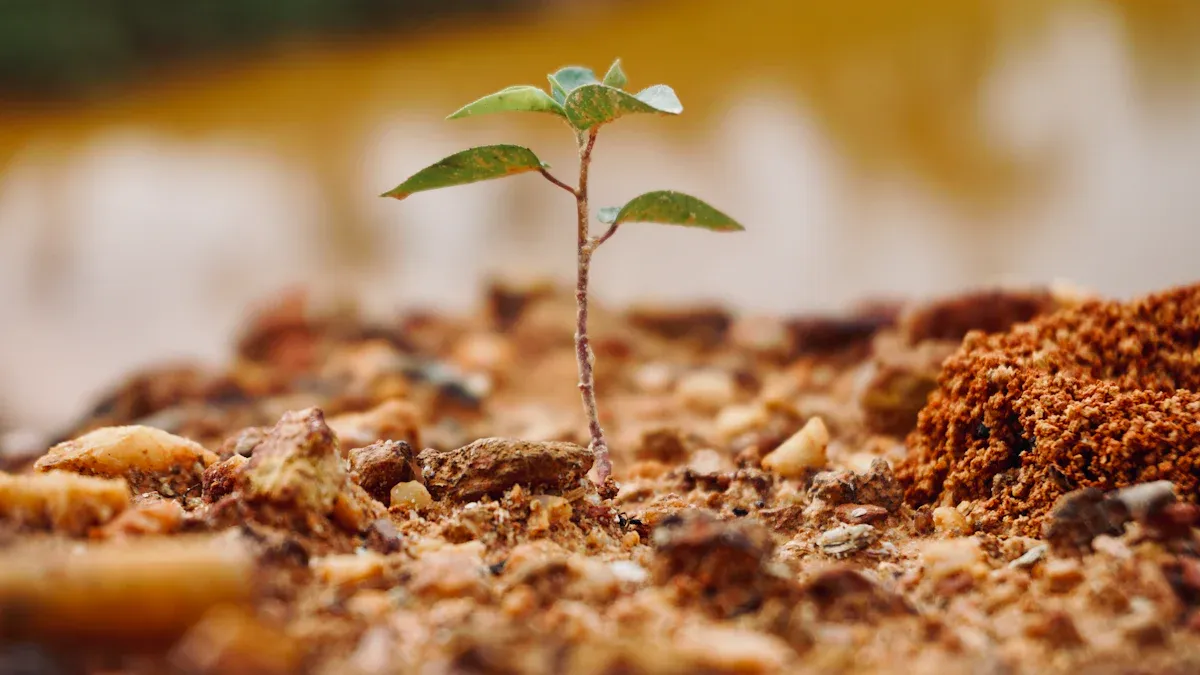
Nutrient Use Efficiency
Humic acid fertilizers help farmers use nutrients better. When farmers add humic substances, their crops grow stronger. These organic materials help soil keep nutrients for a longer time. Plants can get nitrogen, phosphorus, and potassium when they need them. Humic acid helps the soil microbiome. Microbes in the soil become more active and break down organic matter. This lets out nutrients for crops and makes soil healthier.
Scientists found that humic acid changes how soil microbes act. It affects genes that help with nitrogen cycling. This means plants use nitrogen better and waste less. When farmers coat urea with humic acid, less nitrogen escapes into the air. Crops get more nutrients, so they grow bigger and healthier. Humic substances also cost less than many chemical fertilizers. They are simple to use and work well for sustainable farming.
The table below shows how humic acid fertilizers help crops use nutrients better and grow more:
Aspect | Benefits |
|---|---|
Bio-stimulation of soil microbiome | Humic substances help soil microbes, so plants use more nitrogen. |
Microbial nitrogen metabolism | Humic acid changes microbe genes, giving plants more nitrogen. |
Reduction of nitrogen losses | Urea with humic acid keeps more nitrogen in the soil. |
Economic and environmental benefits | Humic acid fertilizers are cheap and good for the environment. |
Crop/System | Effect of Humic Acid Urea (HAU) vs. Urea (U) |
|---|---|
Wheat grain yield increase | |
Nitrogen utilization rate | 14–60% higher in pots |
Summer maize grain yield | 5.58–18.67% higher with HAU |
Shoot biomass | 11.50–21.33% more with HAU |
Nitrogen release and absorption | More nitrogen in topsoil and better root uptake |
Economic aspect | Lower costs and bigger benefits for farmers |
Farmers who use humic acid fertilizers get more crops, healthier soil, and better farming for the future.
Environmental Impact
Humic acid fertilizers help the environment in many ways. These organic products keep soil healthy and lower the need for chemicals. When farmers use humic substances, there is less nutrient runoff and fewer greenhouse gases. Soil holds more water and nutrients, which helps crops and nature.
A three-year study on peanut fields showed great results. Humic acid fertilizer made soil health better and peanut yields went up by over 78% after three years. Soil nutrients increased. Enzyme activities like urease and sucrase got higher. There were more kinds of helpful microbes. These changes made soil richer and crops grew better. The study shows humic acid fertilizers help both soil and sustainable farming.
Farmers see that humic acid fertilizers make soil stronger. More organic matter helps soil fight erosion and drought. Humic substances also help good microbes. These microbes break down organic stuff and keep soil healthy. Farms become more productive and last longer.
Humic acid fertilizers mean farmers use fewer chemicals.
Soil gets healthier, so crops grow better and farms last longer.
Farmers help the environment while growing strong crops.
Healthy soil is important for sustainable farming. Humic acid fertilizers give farmers a natural way to make soil better, grow more crops, and protect the earth.
Future of Sustainable Farming
Innovations
Researchers and companies are finding new ways to use humic acid fertilizers. They use better methods to get and make humic acid work well. Companies like Monty's Plant Food and Organocat, LLC do special tests on humic acid. These tests, like fractional analysis and molecular mass distribution, show how humic acid acts in soil and plants.
Now, many products mix humic acid with other helpful things. Some fertilizers add seaweed extracts, amino acids, or good microbes to humic acid. These mixes help crops grow stronger and healthier. Farmers can pick from liquid, granules, or even feed for animals. Precision agriculture tools and digital platforms help farmers use the right amount of humic acid at the best time.
Tip: When researchers, companies, and governments work together, more farmers start using humic acid for sustainable farming.
Prospects
The future is bright for humic acid fertilizers in farming. Market research shows they will grow a lot in many places. The table below shows what is expected:
Region | CAGR (Forecast Period) | Key Drivers and Opportunities |
|---|---|---|
Asia Pacific | 8.5% | Big farms, more food needed, better farming ways |
North America | 7.8% | More organic food, strict rules, sustainable farming |
Europe | 7.5% | Organic farming rules, EU help for bio-fertilizers |
Farmers in Asia Pacific, North America, and Europe are using more humic acid fertilizers. They want better soil and bigger crops. The market could grow from $1.2 billion in 2023 to $2.6 billion by 2032. This is because people want more organic food, governments give support, and new technology is helping.
Humic acid fertilizers help farms by making soil better and keeping nutrients in the ground. They also help good microbes and help crops use water and fight drought. As more farmers learn about these good things, humic acid will become even more important for sustainable farming.
Humic acid fertilizers are very important for farming. They help soil stay healthy and help plants use nutrients. Crops grow stronger and bigger with these fertilizers. Farmers notice better soil and more crops. They also do not need as many chemical fertilizers. Studies show products like Turbo Root and HUMAC® Agro make soil better. These products help crops handle problems and make farming last longer.
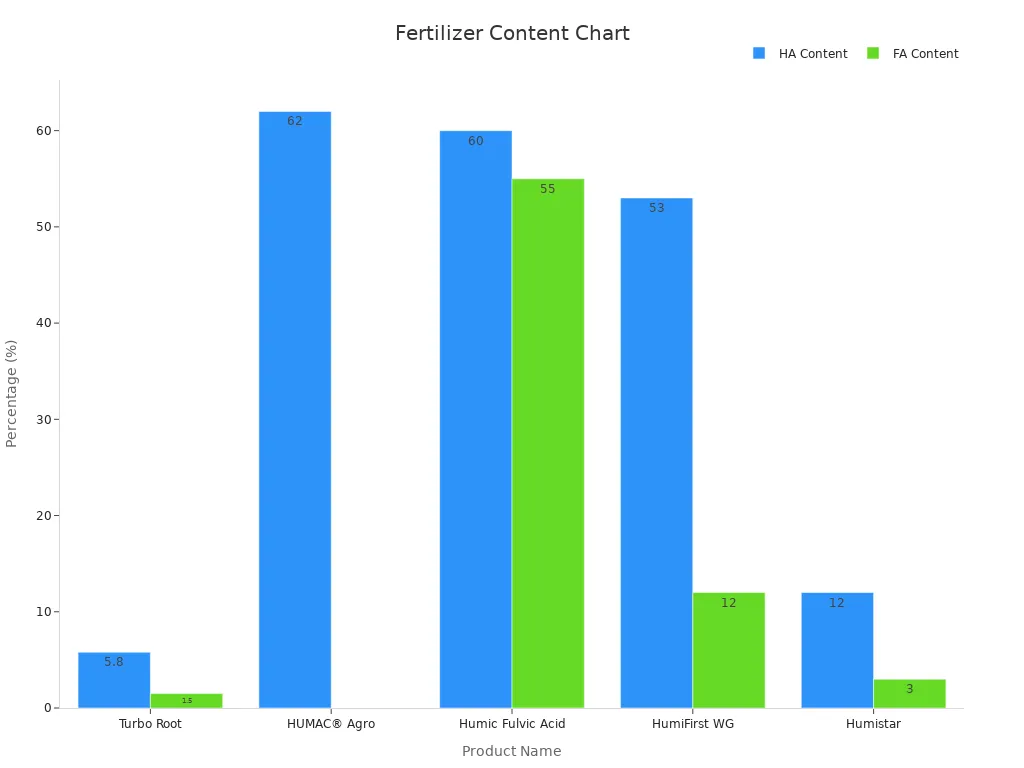
New research shows humic substances help farms and nature. These new ideas can make farming better for the earth.
FAQ
What is humic acid fertilizer made from?
Humic acid fertilizer comes from old plants and animals that have broken down. Companies get humic substances from things like leonardite, peat, or compost. These things have organic compounds that help soil and give more nutrients to plants.
How does humic acid fertilizer help reduce chemical fertilizer use?
Humic acid fertilizer helps soil keep more nutrients and helps plants take them in. Because of this, farmers can use less chemical fertilizer. Crops get more nitrogen, phosphorus, and potassium. This helps farms be more sustainable and saves money.
Can humic acid fertilizer work in all soil types?
Humic acid fertilizer helps almost every kind of soil. It works in sandy, clay, and loamy soils. It makes soil structure better and helps soil hold water. It also helps soil swap nutrients. Farmers see good results in both acidic and alkaline soils.
Is humic acid fertilizer safe for the environment?
Humic acid fertilizer is safe for nature. It helps stop nutrients from running off and lowers greenhouse gases. Farmers use it to help soil microbes and keep soil healthy for a long time.
How should farmers apply humic acid fertilizer?
Farmers can use humic acid fertilizer as a liquid, granule, or powder. They can mix it with water and spray it on leaves or put it right in the soil. How much to use depends on the crop and the soil.
See Also
Comparing Humic Acid And Chemical Fertilizers For Sustainability
A Guide To Potassium Humate Fertilizer For Healthy Plants
Why Mineral Potassium Humate Fertilizer Boosts Crop Success
How Sodium Humate Supports Progress In Agriculture And Industry
